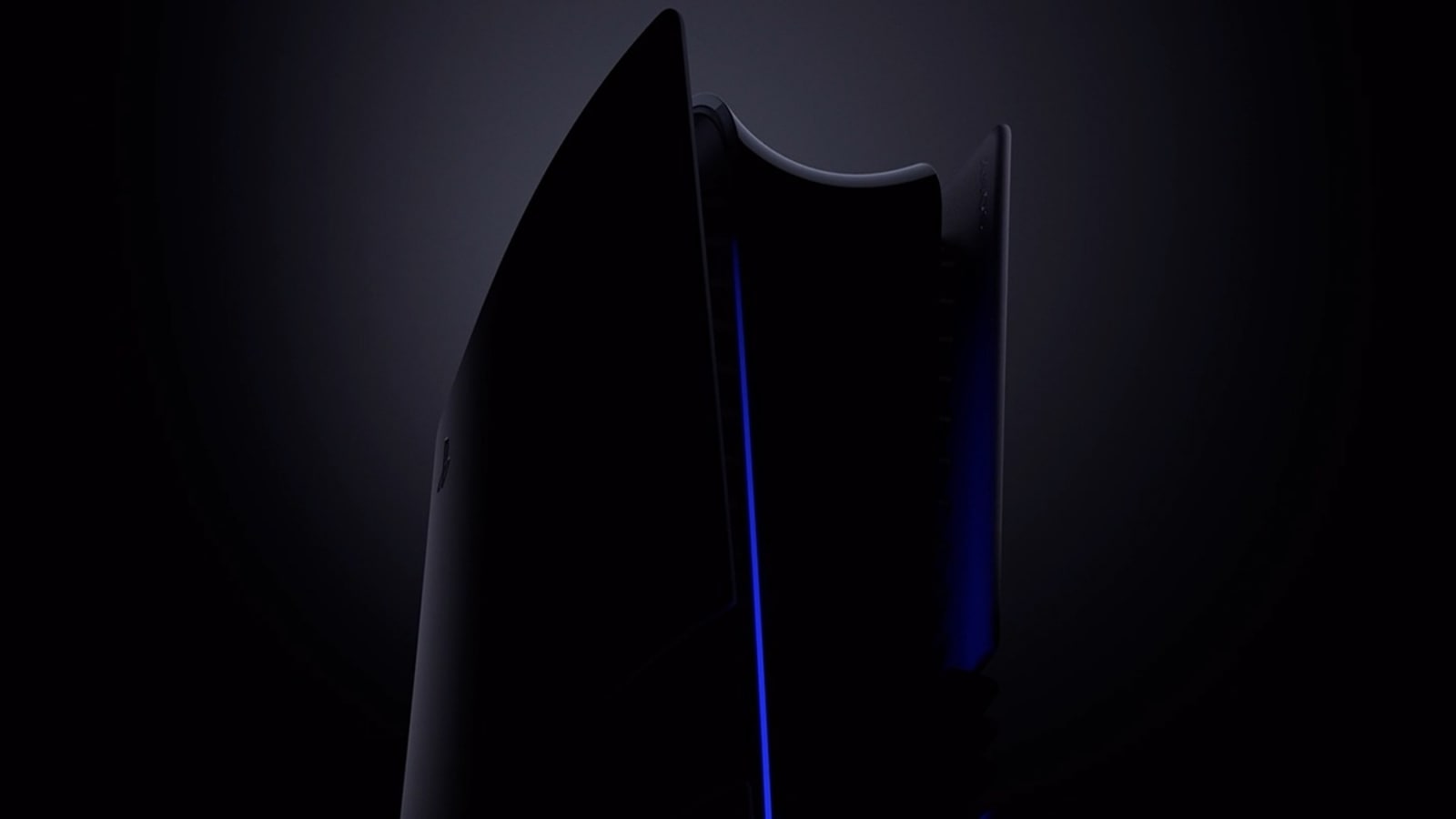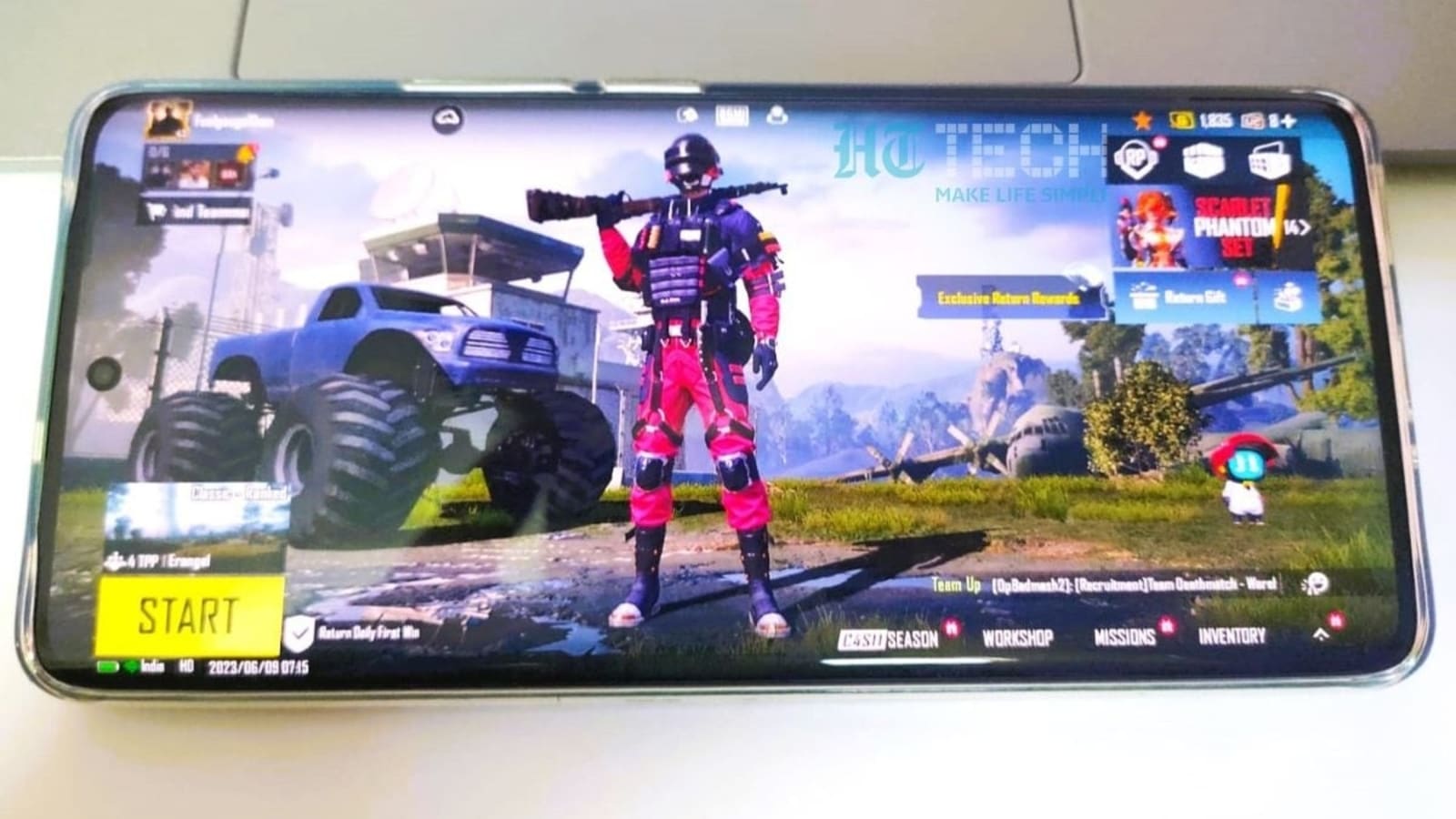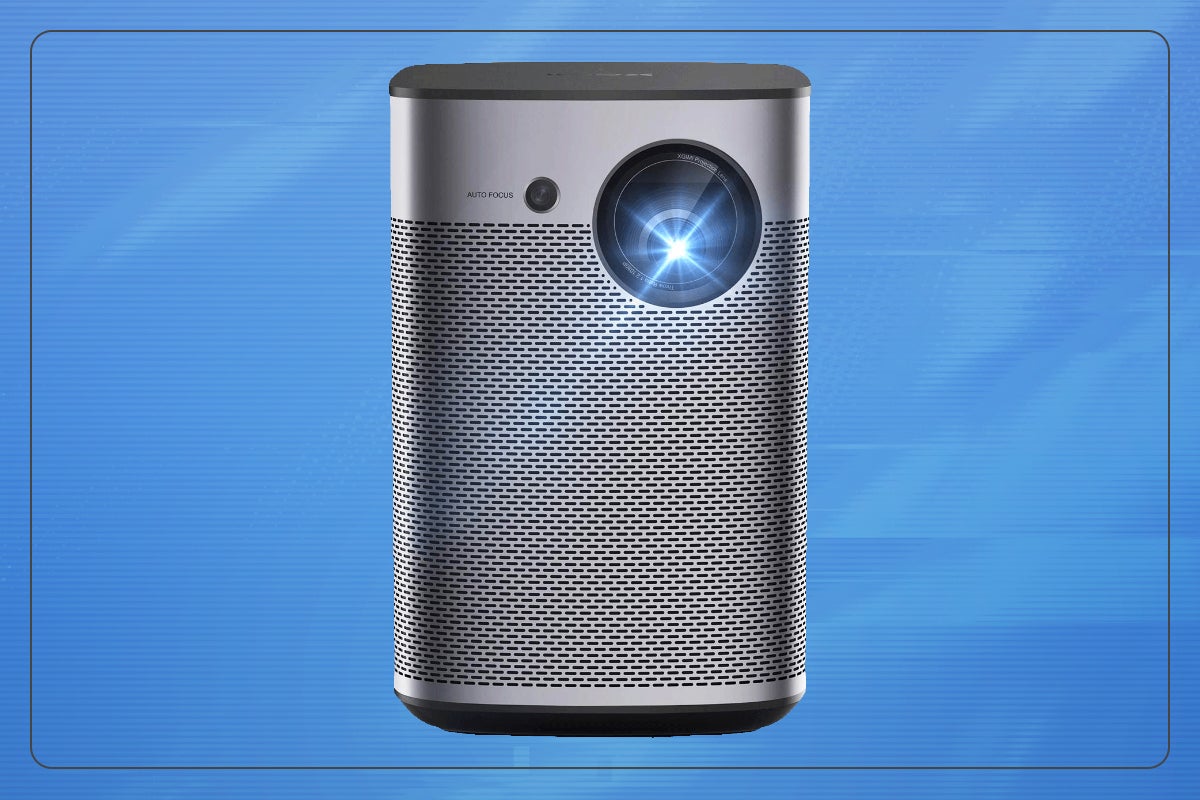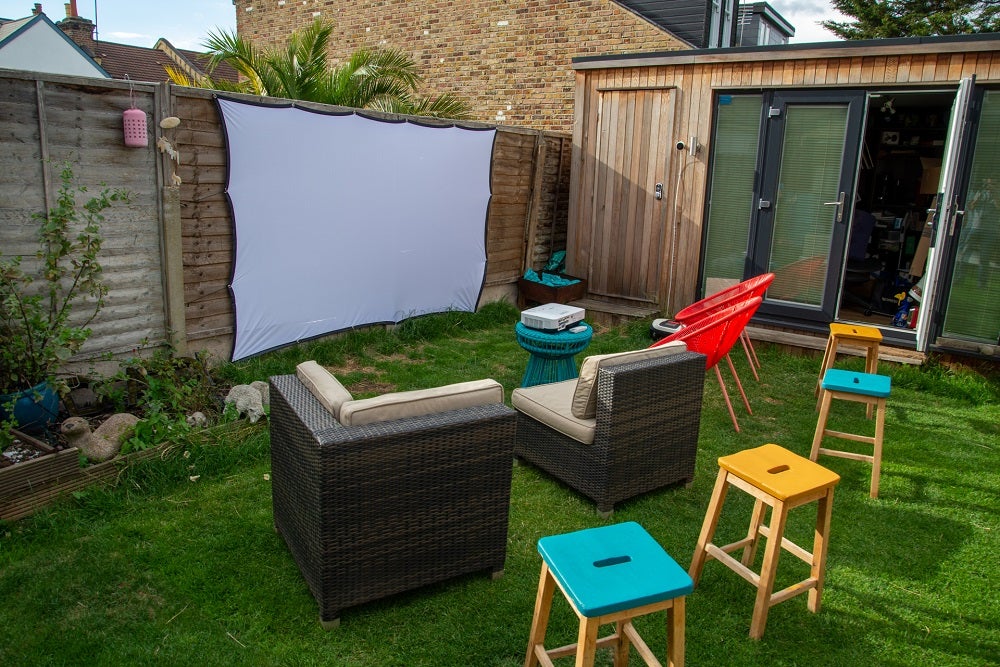Verdict
Although cheaper than its predecessor, the Anker Nebula Cosmos 4K SE introduces Dolby Vision alongside a hybrid LED/laser backlight – It’s a potent combination. With lower brightness than some rivals, HDR content lacks some punch, but this projector produces clean, realistic colours and is still bright enough to watch at large screen sizes without a blackout room.
Pros
- Dolby Atmos
- Clever auto adjustment tools
- Sharp, detailed image
Cons
- Not as bright as its predecessor
- Colours can lack punch
Introduction
The Anker Nebula Cosmos 4K SE marks a leap forward in performance and standards for the projector company, introducing Dolby Vision for the first time in its line-up, along with a dual LED and laser backlight.
This model does sacrifice brightness compared to its predecessor, which means that HDR content doesn’t quite have the punch here that it does on rival models.
Design
- Handy carry handle
- Two HDMI 2.1 ports
The Anker Nebula Cosmos 4K SE looks similar to the Anker Nebula Cosmos Laser 1080P, with a similar carry handle on top that makes it easy to move the projector around the house (well, as easily as you can do for a projector that weighs 4.5kg).
There’s no protection for the lens on the front, so you might want to buy the optional carry case if you intend to move the projector around a lot, particularly outside your home.

There’s no flip stand or integrated adjustment on this projector, so if you want more flexibility as to where it points, you might want to buy a projector and use the standard thread mount underneath. Anker also sells a range of tripods and stands if you prefer.

There are some obvious differences between this and the Cosmos Laser. For starters, the Cosmos Laser had a plug-in Android dongle that went in a flap at the rear, and was required to provide Netflix. As the Anker Nebula Cosmos 4K SE runs Google TV, it’s certified for Netflix, so there’s no need for the dongle.
That makes life easier, and means that there are two free HDMI ports (the Cosmos had one). Both ports are HDMI 2.1, with one supporting HDMI eARC, so you can run sound to a soundbar or speaker system. There’s also a USB port and a 3.5mm audio output.

Aside from a power button, the Anker Nebula Cosmos 4K SE is rather devoid of controls, so the bundled Bluetooth remote is required (or the Nebula app). It’s a very similar remote control to those I’ve seen with other projectors, with the minimum range of controls and an integrated microphone for voice commands.

Here, Anker has added an LED backlight to the remote. It’s a simple upgrade but it does make the remote easier to see when using it in a darkened room.

Features
- Runs Netflix
- Automatic keystone and focus
Google TV has rapidly become the standard for modern smart projectors, and it’s good to see it here. As well as making setup fast (you can use your iOS or Android phone), the operating system supports Netflix natively.
All of the other major streaming apps are available, too, with support for Amazon Prime Video, Apple TV+, Disney+, Now and Paramount+. At the time of writing there was no BBC iPlayer or Channel 4, but ITVX and My5 were there.
As I’ve come to expect, the Anker Nebula Cosmos 4K SE has several smart auto-setup features, including autofocus, auto keystone correction, screen detection and obstacle avoidance. All work well, and make it easy to get a square, in-focus picture. I always have to mention that it is best to get the projector lined up manually as best you can, as the image adjustment features are digital corrections that reduce overall resolution.

New to this model is Wall Color Adaption, which uses the sensors on the front to detect the wall colour and then compensate for it. That’s really handy if you can’t find a plain white wall to project on to, and the system is far more accomplished than the manual systems that let you pick from a limited choice of wall colours. I’ve seen this feature on the JMGO N1S Ultimate 4K, and it’s just as impressive and useful here.

For more in-depth picture control, the projector has a set of image presets that you can choose from, including Standard, Vivid, Sport, Movie, Game and Conference. The new mode is NebulaMaster, where the projector detects highlights and shadows and uses gamma 2.2 curves to adjust contrast dynamically.

When Dolby Vision content is shown, the picture modes change to Dolby Vision Dark, Dolby Vision Bright or Dolby Vision Vivid.
Advanced settings include a colour tuner, and 11 Point White Balance Correction, so the image can be tweaked to suit the environment and content that you’re watching.

Performance
- Dolby Vision helps bring out detail in some content
- Loud, powerful audio
- Can lack punch in some scenes
As a DLP projector, the Anker Nebula Cosmos 4K SE has a 0.47-inch DMD chip inside, which has a native resolution of 1920 x 1080. XPR tech shifts the chip four times per frame to build up a 4K image. This is a mature technology now, and this projector is indistinguishable from a ‘true’ 4K display, with a sharp image from side to side.
It does lock the 4K refresh to 60Hz, which is fine for most content, although it can be worth leaving the motion compensation feature turned on at the lowest setting just to remove any potential judder.
Once again, as seems standard for this kind of projector, the Anker Nebula Cosmos 4K SE has a fixed throw ratio of 1.2:1, so you don’t have to put the projector too far back from the projection surface to get a decent image.
Anker says that this projector can go up to 200-inches, which is realistically bigger than the walls in most homes. Of course, the size of image that you can project depends on the ambient brightness.
Rated at 1800 ANSI Lumens, the Anker Nebula Cosmos 4K SE is slightly dimmer than its predecessor, the Anker Nebula Cosmos Laser. This is likely to be because the Anker Nebula Cosmos 4K SE uses a HybridBeam backlight, combining LED and laser light sources.
It’s similar technology to that on the XGIMI Horizon Ultra, and designed to produce high brightness images with natural colours and get rid of some of the potential downsides to laser backlights, such as speckling. I should point out that the Horizon Ultra manages 2300 ISO Lumens (around 2875 ANSI Lumens), so is considerably brighter.
Overall, Anker says that this projector covers 123% of the Rec.709 colour gamut, and that the backlight will last for 30,000 hours.
That said, 1800 ANSI Lumens isn’t a bad level of brightness at all. At this level, I could watch a large screen (80-inches+) inside with the blinds open. I found that this level of viewing was best for brighter content, and that when watching moodier films I had to shut the blinds.
I found screen brightness to be relatively even, with no noticeable bright or dark patches. I then watched a lot of films and TV to see what the projector is capable of.
Dolby Vision is a welcome addition. With dynamic metadata, each scene is optimised for HDR. It helps create a more natural and rich image than you get with the more generic HDR10, where the metadata is static and built or an entire film or TV show. That said, what’s possible is still limited by a combination of brightness and the backlight, as well as the picture mode chosen.
Watching Kingdom of the Planet of the Apes, I found that the opening funeral scene suffered a little from noise in the picture. Turning the mode from Dolby Vision Bright (image on the left, below) to Dolby Vision Dark (right image) sorted that out and gave a more natural picture.


What the Anker Nebula Cosmos 4K SE can’t do is deliver dark blacks and very bright highlights, as the fire scene shows. The image is good, clean and detailed, but a brighter projector, such as the JMGO N1S Ultimate 4K really brings that scene to life with searing highlights. Below, I’ve got the scene with Dolby Vision Bright (left) and Dolby Vision Dark (Right).


With brighter content, such as the forest scenes in Apes, the Anker Nebula Cosmos 4K SE is very good. Again, colours don’t pop in the same way as they do on a brighter model, but they’re rich, natural and detailed.

Switching to Guardians of the Galaxy 3, the dark scenes with Rocket’s friends are rendered about as well as you can get on a projector. Blacks are pretty good, considering it’s a projected image, and there’s detail throughout the frame.

With the scene in the running wheel with the High Evolutionary, there’s again a difference between Dolby Vision Bright (left) and Dolby Vision Dark (right). I found that Bright option gave more detail, but with more noise. Overall, a brighter projector, such as the Horizon Ultra or N1S Ultimate 4K are better at extracting more detail.


Dual 15W speakers are built-in with support for Dolby Audio and Dolby Digital Plus. They’re pretty good speakers, on par with a good television set. I found them clear for audio, loud enough to fill a room and well-balanced. They lack some bass, but for general watching, they’re good; for fixed use, I’d likely use the eARC output with a more powerful surround system.
Latest deals
Should you buy it?
You want Dolby Vision and Netflix
Overall great image quality and good contrast ratios, mixed with integrated Netflix make this portable projector a good all-rounder.
You want more brightness
If you want to make the most out of HDR content or watch under a wider range of lights, you’ll want a brighter projector.
Final Thoughts
There’s a lot of competition, all with various limitations and benefits. The XGIMI Horizon Ultra is brighter and also has Dolby Vision but it doesn’t have a native Netflix client, and it costs a few hundred pounds more.
Spend more on the JMGO N1S Ultimate 4K and you get a much brighter picture and a more flexible stand, although you sacrifice Dolby Vision. With the Anker Nebula Cosmos 4K SE, the price is very good for a Dolby Vision projector and there’s Netflix built-in, although it’s not quite as bright as the competition. For a range of alternatives, read our guide to the best portable projectors.
How we test
We test every projector we review thoroughly over an extended period of time. We use industry standard tests to compare features properly. We’ll always tell you what we find. We never, ever, accept money to review a product.
Find out more about how we test in our ethics policy.
FAQs
Yes, running Google TV, this projector has a native, official Netflix client.
Verdict
Although cheaper than its predecessor, the Anker Nebula Cosmos 4K SE introduces Dolby Vision alongside a hybrid LED/laser backlight – It’s a potent combination. With lower brightness than some rivals, HDR content lacks some punch, but this projector produces clean, realistic colours and is still bright enough to watch at large screen sizes without a blackout room.
Pros
- Dolby Atmos
- Clever auto adjustment tools
- Sharp, detailed image
Cons
- Not as bright as its predecessor
- Colours can lack punch
Introduction
The Anker Nebula Cosmos 4K SE marks a leap forward in performance and standards for the projector company, introducing Dolby Vision for the first time in its line-up, along with a dual LED and laser backlight.
This model does sacrifice brightness compared to its predecessor, which means that HDR content doesn’t quite have the punch here that it does on rival models.
Design
- Handy carry handle
- Two HDMI 2.1 ports
The Anker Nebula Cosmos 4K SE looks similar to the Anker Nebula Cosmos Laser 1080P, with a similar carry handle on top that makes it easy to move the projector around the house (well, as easily as you can do for a projector that weighs 4.5kg).
There’s no protection for the lens on the front, so you might want to buy the optional carry case if you intend to move the projector around a lot, particularly outside your home.

There’s no flip stand or integrated adjustment on this projector, so if you want more flexibility as to where it points, you might want to buy a projector and use the standard thread mount underneath. Anker also sells a range of tripods and stands if you prefer.

There are some obvious differences between this and the Cosmos Laser. For starters, the Cosmos Laser had a plug-in Android dongle that went in a flap at the rear, and was required to provide Netflix. As the Anker Nebula Cosmos 4K SE runs Google TV, it’s certified for Netflix, so there’s no need for the dongle.
That makes life easier, and means that there are two free HDMI ports (the Cosmos had one). Both ports are HDMI 2.1, with one supporting HDMI eARC, so you can run sound to a soundbar or speaker system. There’s also a USB port and a 3.5mm audio output.

Aside from a power button, the Anker Nebula Cosmos 4K SE is rather devoid of controls, so the bundled Bluetooth remote is required (or the Nebula app). It’s a very similar remote control to those I’ve seen with other projectors, with the minimum range of controls and an integrated microphone for voice commands.

Here, Anker has added an LED backlight to the remote. It’s a simple upgrade but it does make the remote easier to see when using it in a darkened room.

Features
- Runs Netflix
- Automatic keystone and focus
Google TV has rapidly become the standard for modern smart projectors, and it’s good to see it here. As well as making setup fast (you can use your iOS or Android phone), the operating system supports Netflix natively.
All of the other major streaming apps are available, too, with support for Amazon Prime Video, Apple TV+, Disney+, Now and Paramount+. At the time of writing there was no BBC iPlayer or Channel 4, but ITVX and My5 were there.
As I’ve come to expect, the Anker Nebula Cosmos 4K SE has several smart auto-setup features, including autofocus, auto keystone correction, screen detection and obstacle avoidance. All work well, and make it easy to get a square, in-focus picture. I always have to mention that it is best to get the projector lined up manually as best you can, as the image adjustment features are digital corrections that reduce overall resolution.

New to this model is Wall Color Adaption, which uses the sensors on the front to detect the wall colour and then compensate for it. That’s really handy if you can’t find a plain white wall to project on to, and the system is far more accomplished than the manual systems that let you pick from a limited choice of wall colours. I’ve seen this feature on the JMGO N1S Ultimate 4K, and it’s just as impressive and useful here.

For more in-depth picture control, the projector has a set of image presets that you can choose from, including Standard, Vivid, Sport, Movie, Game and Conference. The new mode is NebulaMaster, where the projector detects highlights and shadows and uses gamma 2.2 curves to adjust contrast dynamically.

When Dolby Vision content is shown, the picture modes change to Dolby Vision Dark, Dolby Vision Bright or Dolby Vision Vivid.
Advanced settings include a colour tuner, and 11 Point White Balance Correction, so the image can be tweaked to suit the environment and content that you’re watching.

Performance
- Dolby Vision helps bring out detail in some content
- Loud, powerful audio
- Can lack punch in some scenes
As a DLP projector, the Anker Nebula Cosmos 4K SE has a 0.47-inch DMD chip inside, which has a native resolution of 1920 x 1080. XPR tech shifts the chip four times per frame to build up a 4K image. This is a mature technology now, and this projector is indistinguishable from a ‘true’ 4K display, with a sharp image from side to side.
It does lock the 4K refresh to 60Hz, which is fine for most content, although it can be worth leaving the motion compensation feature turned on at the lowest setting just to remove any potential judder.
Once again, as seems standard for this kind of projector, the Anker Nebula Cosmos 4K SE has a fixed throw ratio of 1.2:1, so you don’t have to put the projector too far back from the projection surface to get a decent image.
Anker says that this projector can go up to 200-inches, which is realistically bigger than the walls in most homes. Of course, the size of image that you can project depends on the ambient brightness.
Rated at 1800 ANSI Lumens, the Anker Nebula Cosmos 4K SE is slightly dimmer than its predecessor, the Anker Nebula Cosmos Laser. This is likely to be because the Anker Nebula Cosmos 4K SE uses a HybridBeam backlight, combining LED and laser light sources.
It’s similar technology to that on the XGIMI Horizon Ultra, and designed to produce high brightness images with natural colours and get rid of some of the potential downsides to laser backlights, such as speckling. I should point out that the Horizon Ultra manages 2300 ISO Lumens (around 2875 ANSI Lumens), so is considerably brighter.
Overall, Anker says that this projector covers 123% of the Rec.709 colour gamut, and that the backlight will last for 30,000 hours.
That said, 1800 ANSI Lumens isn’t a bad level of brightness at all. At this level, I could watch a large screen (80-inches+) inside with the blinds open. I found that this level of viewing was best for brighter content, and that when watching moodier films I had to shut the blinds.
I found screen brightness to be relatively even, with no noticeable bright or dark patches. I then watched a lot of films and TV to see what the projector is capable of.
Dolby Vision is a welcome addition. With dynamic metadata, each scene is optimised for HDR. It helps create a more natural and rich image than you get with the more generic HDR10, where the metadata is static and built or an entire film or TV show. That said, what’s possible is still limited by a combination of brightness and the backlight, as well as the picture mode chosen.
Watching Kingdom of the Planet of the Apes, I found that the opening funeral scene suffered a little from noise in the picture. Turning the mode from Dolby Vision Bright (image on the left, below) to Dolby Vision Dark (right image) sorted that out and gave a more natural picture.


What the Anker Nebula Cosmos 4K SE can’t do is deliver dark blacks and very bright highlights, as the fire scene shows. The image is good, clean and detailed, but a brighter projector, such as the JMGO N1S Ultimate 4K really brings that scene to life with searing highlights. Below, I’ve got the scene with Dolby Vision Bright (left) and Dolby Vision Dark (Right).


With brighter content, such as the forest scenes in Apes, the Anker Nebula Cosmos 4K SE is very good. Again, colours don’t pop in the same way as they do on a brighter model, but they’re rich, natural and detailed.

Switching to Guardians of the Galaxy 3, the dark scenes with Rocket’s friends are rendered about as well as you can get on a projector. Blacks are pretty good, considering it’s a projected image, and there’s detail throughout the frame.

With the scene in the running wheel with the High Evolutionary, there’s again a difference between Dolby Vision Bright (left) and Dolby Vision Dark (right). I found that Bright option gave more detail, but with more noise. Overall, a brighter projector, such as the Horizon Ultra or N1S Ultimate 4K are better at extracting more detail.


Dual 15W speakers are built-in with support for Dolby Audio and Dolby Digital Plus. They’re pretty good speakers, on par with a good television set. I found them clear for audio, loud enough to fill a room and well-balanced. They lack some bass, but for general watching, they’re good; for fixed use, I’d likely use the eARC output with a more powerful surround system.
Latest deals
Should you buy it?
You want Dolby Vision and Netflix
Overall great image quality and good contrast ratios, mixed with integrated Netflix make this portable projector a good all-rounder.
You want more brightness
If you want to make the most out of HDR content or watch under a wider range of lights, you’ll want a brighter projector.
Final Thoughts
There’s a lot of competition, all with various limitations and benefits. The XGIMI Horizon Ultra is brighter and also has Dolby Vision but it doesn’t have a native Netflix client, and it costs a few hundred pounds more.
Spend more on the JMGO N1S Ultimate 4K and you get a much brighter picture and a more flexible stand, although you sacrifice Dolby Vision. With the Anker Nebula Cosmos 4K SE, the price is very good for a Dolby Vision projector and there’s Netflix built-in, although it’s not quite as bright as the competition. For a range of alternatives, read our guide to the best portable projectors.
How we test
We test every projector we review thoroughly over an extended period of time. We use industry standard tests to compare features properly. We’ll always tell you what we find. We never, ever, accept money to review a product.
Find out more about how we test in our ethics policy.
FAQs
Yes, running Google TV, this projector has a native, official Netflix client.



























